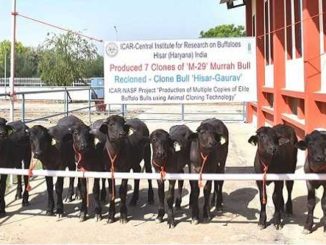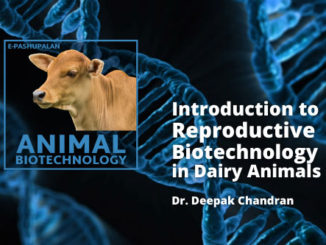Synchronization is the process in which we bring group of animals together in estrus within a stipulated period of time. In a group of randomly cycling females, the time of occurrence of estrus cannot be predicted with certainty for an individual animal. Detection of estrus is time consuming, laborious and subject to human error. Thus synchronization of estrus in a group of females allows one to predict the time of estrus with reasonable accuracy.
Selection of animals for Synchronization
- Should have passed 45-50 days of post partum
- Should not be fatty but well nourished
- Should not have any abnormal discharge
- Plan the program in conjunction with A.I persons
Don’t stress animals during synchronization
Application of Synchronization
Still today low pregnancy rate is assigned for failure to detect estrus timely & accurately.
- Controlled breeding program allow to detect estrus timely & accurately
Using PG
(1) Controlled breeding with ovarian palpation
- Animals > 50 days postpartum were palpated for responsive CL
- Responsive CL animals received PG
- Observed of estrus 3x time on 2,3,4 & 5 day post injection
- Inseminate those reported in heat
- Animals without responsive CL & non responder of PG were again bring back to program (Max 3 times)
(2) Controlled breeding without ovarian palpation
(a) 7 days program (Monday morning program)
- No palpation of ovary required
- All animal receive PG (Monday)
- Observed heat from wed – sat
- Inseminate those observed in heat
- Non-responder again brought to program next Monday
Advantage
- Inaccuracy in CL palpation is removed
- Though more PG doses is required, however,it is less costlier compare to those animals having CL but missed for detection during rectal examination
(b) 11-14 days program
- Similar in all respect as 7 days program except that re injection required either at 11 or 14 days
Targeted breeding program
- Purpose is to synchronize (set up) animals into stage of the cycle when they are most likely to respond to the breeding shot of PG administer 14 days later
- VWP – 14 days receive PG (set up dose or 1st PG)
- Breeding shot (2nd dose of PG ) 14 days later
- Observe estrus 2-5 days post breeding shot of PG
- Non-responder again treated after 14 days
Modified targeted breeding(Gn-RH + PG)
- VWP-21 days (Ist PG)
- Gn-RH injection 14 days later
- II nd PG injection after 7 days of Gn-RH
- Observed heat next 3 days of last PG and inseminate those found in heat
- Animals not observed in heat were inseminated between 72-80 hr following last PG
- All cows are thus inseminated
Ovsynch (Gn-RH7 – PG – Gn-RH2 – timed AI)
- The first Gn-RH affect follicular growth by causing either ovulation or lutenization of the dominant follicle and prevents estrus until after the PG injection which causes the corpus luteum or lutenized follicle to regress
- New dominant follicle forms and will be available to ovulate by second Gn-RH 48 hr after PG
Advantage
- Synchronize follicular development & ovulation
- Effective timed AI is possible
Important points to consider with Ovsynch program
- Time of first Gn-RH is not critical, however, time of second Gn-RH is critical
- Program should not include heifers
- If a cow exhibits estrus during the course of hormonal treatment , she should be inseminated and further hormonal therapy be stopped
- Program will be useful for animals which fails to respond to estrus following several attempts with PG treatment
- Useful in herds where animals are not turned out for heat detection on routine basis
Presynch Program (Ovsynch preceded by PG)
- Purpose is to synchronize a group of cows into a stage of their cycle where they respond maximum to ovsynch program
- Ovsynch – 28 days (± 3 days) – Ist PG
- II nd PG – 14 days after Ist PG
- Advantage : though more number of injection is there but have better synchrony







Be the first to comment